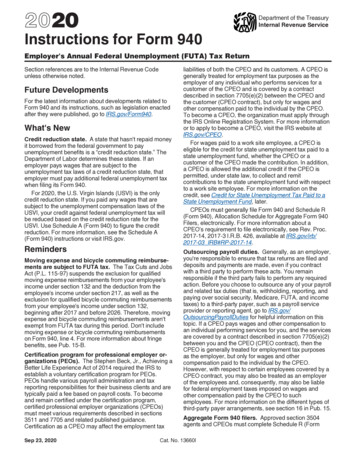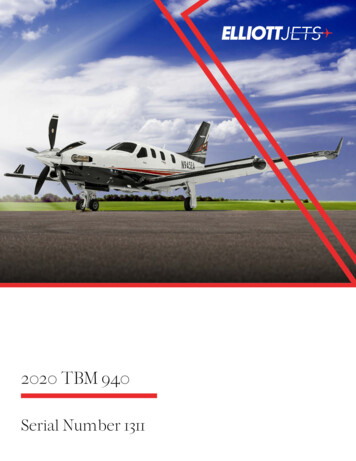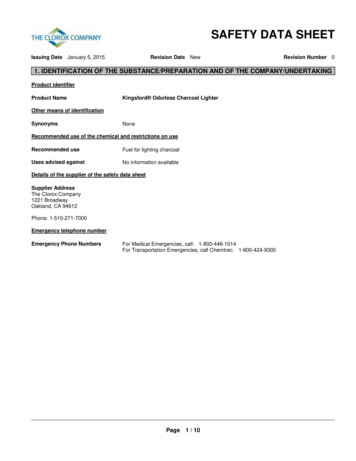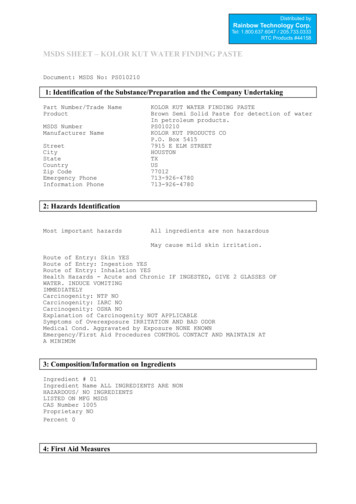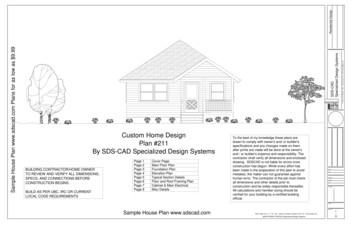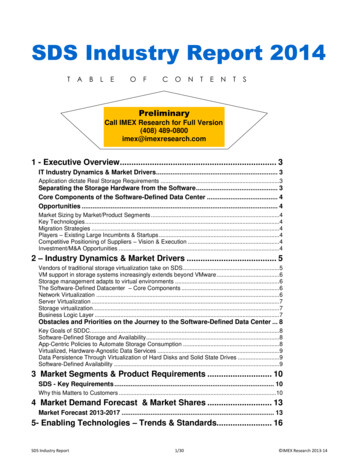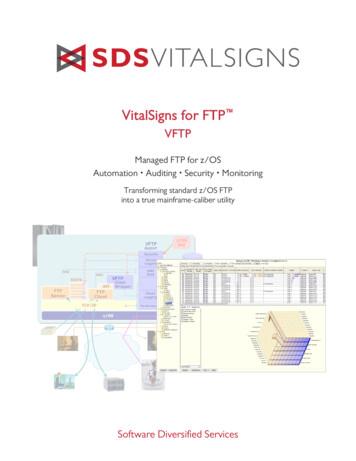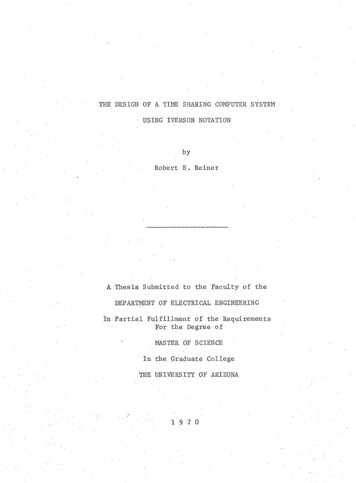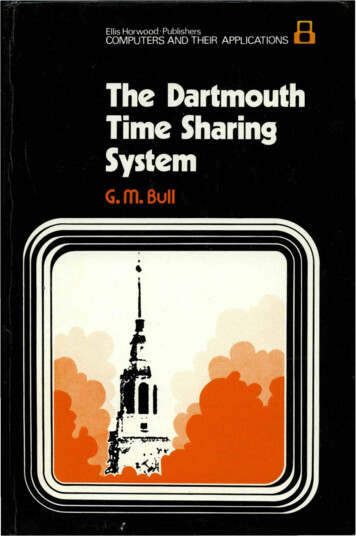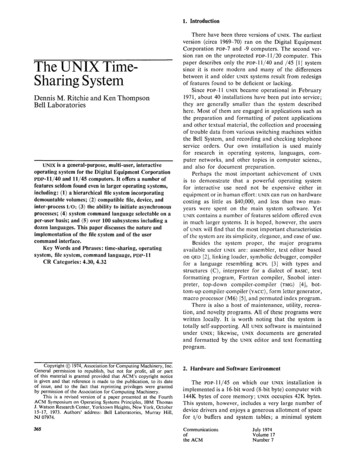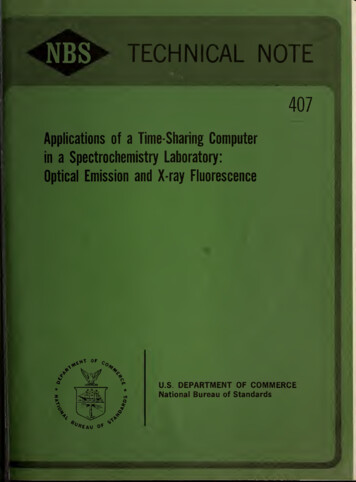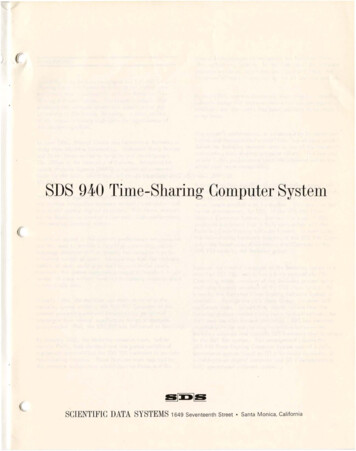
Transcription
r.SDS 940 Time-Sharing Cornputer SystemSCIENTIFIC DATA SYSTEMS1649 Seventeenth Street· Santa Monica, California
FOREWORDScientific Data Systems developed the sqs 940 TimeSharing Computer System to bri ng to the market newequipment that is compatible with the Berkeley TimeSharing Software System. The research project thatproduced this software system was conducted at theUniversity of California, Berkeley. A brief reviewof the project's history highlights the significance ofthis pioneering effort.In June 1963, Project Genie was initiated at Berkeley tostudy Man-Machine Interaction. Professors Harry Huskeyand David Evans served as co-principal investigators.The Offi ce of the Secretary of Defense, Advanced Research Projects Agency (ARPA), provided all necessaryfunds for the work, which was performed under ContractSD-185.The technical approach employed required the simultaneous on-line interaction between several investigators anda powerful central digital computer. This factor prompted the decision to develop a low-cost, high-performance,time-sharing computer system.A critical aspect of the system's performance requirementswas the need to provide a very high capability, multilanguage structure with extremely fast response time fora limited number of users. Recognizing that the ultimatenumber of users could grow well beyond initial needs,however, the system designers arranged to handle a largernumber of users without severely decreasing responsivenessto any single user.In early 1964, the decision was made to develop theBerkeley system utilizing the SDS 930 Computer as thecentral processing unit and incorporating peripheralequipment from several suppliers as design progressed.In September 1964, the SDS 930 was delivered to Berkeley.By January 1965, the Berkeley research team, led byMelvin Pirtle, had obtained and integrated peripheralequipment and modified the SDS 930 hardware to providetime-sharing features. These features were required bythe software architecture established by Pirtle and Dr.Wayne Lichtenberger to implement the Berkeley TimeSharing Software System. In the meantime, the softwarepackage was being developed and, by April 1965, thehardware/software system was on the air and operational.By mid-1965, various documents describing the Berkeleysystem's design and implementation had become publiclyavailable and the system had been publicly demonstratedmany times.The system's performance, as evidenced by its documentation and demonstrated capabilities, has already established the Berkeley research work as one of the industry'soutstandi og time-shari ng computer efforts. The low costat which this performance has been achieved makes theeffort even more remarkable.Recognizing how significantly the Berkeley project advanced the state-of-the-art in time-sharing computation,SDS decided .to make the Berkeley Time-Sharing Software System available to the market. This decision ledto the development, by SDS, of the SDS 940 TimeSharing Computer System. The result is a set of SDSproduced equipment that is fully compatible with theBerkeley Time-Sharing Software System. In particular,the time-shoring hardware features of the SOS 940 Computer are based upon documented modifications to theSDS 930 made by the -Berkeley group.Because the central computer of the Berkeley system is amodified SDS 930, which has a fully compati ble 930Operating mode, members of the Berkeley project automatically became members of the SDS Users Group. Asa result, the Berkeley Time-Sharing Software System isavai lable, through the SDS Users Group, to other SDSequipment users. In addition, modifications that theBerkeley project members may make to their software fortheir own use also become available. SDS has assumedresponsibility for maintaining interfaces between theBerkeley software and specific SDS hardware that is uniqueto the SDS 940 system. This arrangement assures theSDS 940 Time-Sharing Computer System user of a fullyoperational system based on (1) a hardware extension ofa field-proven digital computer and (2) a demonstrated,fully operational software system.iii
SDS 940 Time-Shari ng ComputerIV
BERKELEY TIME-SHARINGSOFTWARE SYSTE 'I/\ CONTENTSFOREWORD SDS 940 CHARACTERISTICSIIIviINTRODUCTION DEFINITION OF TIME SHARINGCHARACTERISTICS OF TIME-SHARIN GCOMPUTER UTILIZATION. Time-Sharing MonitorTime-Sharing Executi veSystem Programmed Operators(SYSPOPs). Symbol ic Macro-AssemblerDDT.QED.LISP. SNOBOL.FORTRAN IIConversational AlgebraicLanguage (CAL)HELP System Operati on 78888888889TIME-SHARING FUNCTIONALREQUIREMENTS. 2SDS 940 TIME-SHARING HARDWAREFEATURES.2PLANNED SOFTWARE EXTENSIONS.92233Dynamic Real-Time Operations.ALGOL. System Mai nte nonce9SDS 940 SPECIFICATJONSGeneralOperati ng Modes .Memory Map.System Programmed Operators(SYSPOPs). Mode-Changi ng Capabi I i ty. Hardware Hang-Up PreventionBerkeley Time-SharingCommunications System . 66779999SOFTWARE DISTRIBUTION9HARDWARE CONFIGURATIONS9Requirements for Berkeley SystemDiagnostics and 930 Mode Support.Opti ons for Performance Increase 91111v
SDS 940 CHARACTERISTICS Typical execution times (including memory access andindexing)Fixed- Poi nt Operati ons (i n microseconds)The SDS 940 is a high-speed, low-cost, general-purposedigital computer that is an extension of the SDS 930.As such, it is fully compatible with all other SDS 900Series computers. The special features on the SDS 940that are in addi tion to th ose on the 930 inc I ude:AddMultiply3.57.0Floating-Point Operations (in microseconds) Monitor and User modes of operation with a set ofpri v ileged instructions that are reserved to the Monitor mode. 930 Operation mode, which makes the SDS 940operate exactly as an SDS 930. A hardware-implemented "memory map" that providesfor dynamically relocating, protecting, and executingprograms in scattered fragments of memory. System Programmed Operators (SYSPOPs), wl1i chmake Monitor mode service routines available toUser mode programs without loss of system controlor use of user memory space. 24-Bit Fraction(plus 9-bit Exponent)AddMultiply Parity checking of all memory and input/ outputoperati ons Priority Interrupt SystemSDS I/ O Options Interrupts two levels standard,38 optionalSystem Interrupts, 896 optional Optional power fail-safe feature permits saving contents of memory and programmable registers in caseof power fa i lure. Up to four I/O communication channels (with optionalinterlacing capability), time-multiplexed with computer operation, providing input/output rates of upto one word per 3.5 microseconds An optional Direct Memory Access System that allowsi nput/ output transfer to occur si mu I taneousl y withcomputer memory access, providing input/ outputrates of up to one word per 1.75 microseconds One to four Direct Access Communication Channelsthat incorporate the Direct Memory Access System Data Multiplex Channel that uses direct memoryaccess connection and accepts/ transmits informationfrom external devices, or subchannels, which cal)operate simultaneously; thus, externally controlledand sequenced equipment can perform input/ output1.75-microsecond cycle time 24-bit word plus parity bit Binary arithmetic Single address instructions withIndex RegisterIndirect AddressingProgrammed Operators Memory overlap between Central Processor and I/Owith two memory banks Memory available in 4, 8, and 16 K banks Multiprecision programming facilityvi92147Program interchangeability with other SDS 900 SeriesComputersBasi c core memory 4096 words, expandable to65,536 words, all addressable withAs an extension of the SDS 930, the SDS 940 retains allof the following characteristics:7754 Nonstop operation protection, which ensuresagainstprogram hang-ups due to infinite indirect addressloops or Execute instruction loops.O. 7-microsecond access time39-Bit Fraction(plus 9-bit Exponent)
buffering and control operations rather than thecomputer. MAGPAK Magnetic Tape SystemMagnetic-tape units (IBM-compatible; binary andBCD)Time-Multiplexed Input/Output Channels operateupon either words or characters. A 6-bit characteris the standard character size; 6- and 12-bit characters, or 6-, 12-, and 24-bit characters can be specified as desired. Direct Access Channels operate uponwords and characters. These channels accept 6-, 8-,12-, and 24-bit characters. The number of charactersper words is specified by the external device.Auxiliary disc files Input/output with Scatter-Read and Gather-WritefacilityCommunications equipment, teletype consoles,display oscilloscopes Standard i nput/ outputA/D converters, digital multiplexer equipment,and other special system equipmentTime-Multiplexed Communication Channel (without interlace)Punched-card equipmentLine printers, graph plottersTypewriter with electromechanical paper-tapereader and punch FORTRAN II and symbol i c assembler as part of complete software package All-silicon semiconductors Operating temperature range: 10 Dimensions: Power: 3 kvaControl Consofe Optional input/output devices00to 40 CAutomati c typewri terPhotoe lectri c paper-tape reader and paper-tapepunch, and spooler mounted on cart124 inches x 25-1/2 inches x 65 inchesVII
rINTRODUCTIONThe new SDS 940 Computer is the first low-cost systemdesigned specificolly for generol-purpose simultaneous,use by many users. The SDS 940 is unique in that itprov ides, within a 400,000 computer system, the broadrange of programming languages and aids generallyfound only on multimillion dollar computers. Likemultimillion dollar time-sharing systems, the SDS 940has advanced, soph isti cated hardware to deal effi cientIy with system organi z atio n problems that are uniquelycharacteristic of a time-sharing mode of use.Developed as an outgrowth of a research program at theUniversity of California, Berkeley, the SDS 940 uses thecurrently operational Berkeley Time-Sharing SoftwareSystem and is an e xtension of the high-performanceSDS 930 Computer. , Thus, the 940 user is assured of afield-proven, thoroughly operational system with anexi sti ng and demonstrable ti me-shari ng software package.In summary, the SDS 940 permits up to 32 active usersto engage simultaneously in on- line program preparationand debugging. Each user v iews the SDS 940 systemas if he has a 16, 384-word, 1. 75-mi crosecond-memorycycle computer at his sole disposal. A single SDS 940Com puter gives the user multiple computer capabilityat a price of a single computer with few, if any, ofthe programming or operating restrictions found on othermedium-priced time-sharing systems.System response times are a functi on of the number ofactive users. Typical times are:6 active users Multiprogramming--Several independent, but perhapsrelated, programs or routines residing and operatingwithin a single computer system. Mu Iti processi ng--Severa I program processes are e xecuted concurrently withi n a computer configurationconsisting of two or more central processing units. Real-Time Processing--Program execution that satisfies a parti cu lar operati onal response time, wh i ch canrange down to microseconds. Remote Processi ng--User i nput/ output devi ces areconnected by commun i cation facilities to a remotelylocated computer system. Interactive or On-Line Processing--A computer system serves a human user or device through directcommunication. For users this often includes conversational interaction. Multiple Access--Several on-line communicationchannels provide access to common computer system.CHARACTERISTICS OF TIME-SHARINGCOMPUTER UTILIZATION1 second20 acti ve users2 seconds32 active users3 secondsDEFINITION OF TIME SHARING"fining the term prove less useful, however, than doeslisting those aspects that characterize current time-sharing systems. Depending upon the application or theg'oals of those concerned with a particular system, oneor more of the following aspects of time sharingpredominates:Because time sharing is a generalized term, it assumesdifferent meanings for different people. Attempts at de-Time-sharing operation of a computer system permitsallocating use of both space and time on a temporaryand dynamically changing basis. Several user programscan reside in core memory at one time while manyothers reside temporarily in auxiliary disc memory.Computer control is turned over to a resident programfor a scheduled time interval or until the programreaches a delay point (such as an I/ O operation),whichever occurs first. At this time the user's programcan be dumped to disc and subsequently reloaded fromdisc when his next turn for machine use occurs. Under
these conditions, several critical time-sharing operational characteristics become clear:requirements by providing the following features: 1. To conserve core space and minimize swaptime, user programs should share common routineswherever possibl e.2. The interchange of programs between discand core on a rapidly changing demand basis literally"tears" memory to shreds, leaving space available forprogram loading in a fragmented, randomly distributedform. Monitor and User modes of operation together withthe establishment of and control over a set of privileged instructions that are reserved to the Monitormode. The privileged instruction set precludes Userexecution of any instruction that affects peripheralequipment, halts the computer, or changes the modeto the Monitor state w ithout relinquishing control ofthe computer to a Monitor state program. System Programmed Operators (SYSPOPs). SYSPOPsare instruction-structured, generalized calls to theoperating system for specific services provided withthat system. Their inclusion, together with the memory map, makes it possible ' to include and efficientlycall public routines as common procedures availableto all programs. Provision of arbitrary interruptibility for long or indefinite sequences of indirect addresses or Executeinstructions. Th is feature assures that no program canhang up the computer through the improper executionof an infinite indir
time-sharing computer system. A critical aspect of the system's performance requirements was the need to provide a very high capability, multi language structure with extremely fast response time for a limited number of users. Recognizing that the ultimate number of users could grow well beyond initial needs, however, the system designers arranged to handle a larger number of users without .
